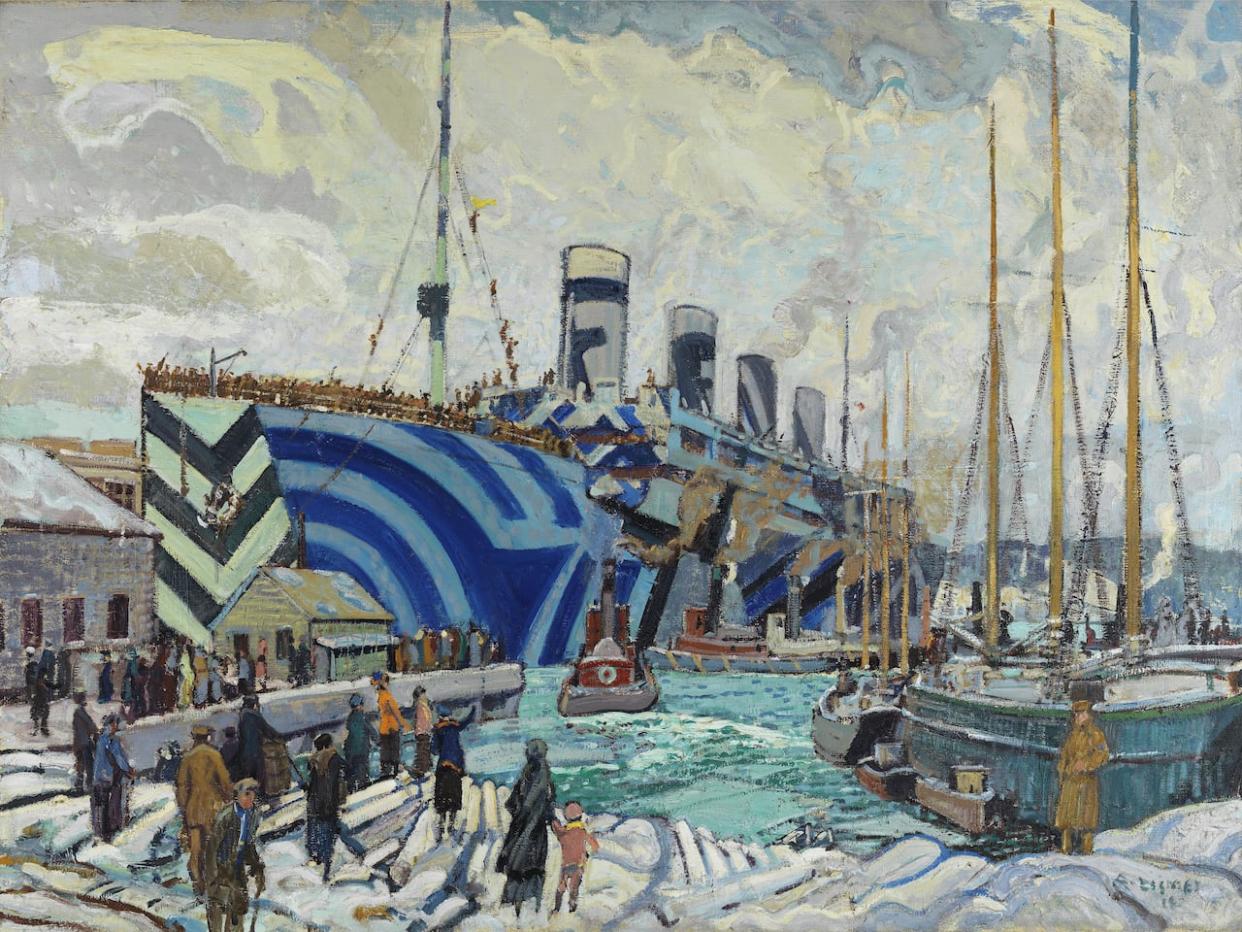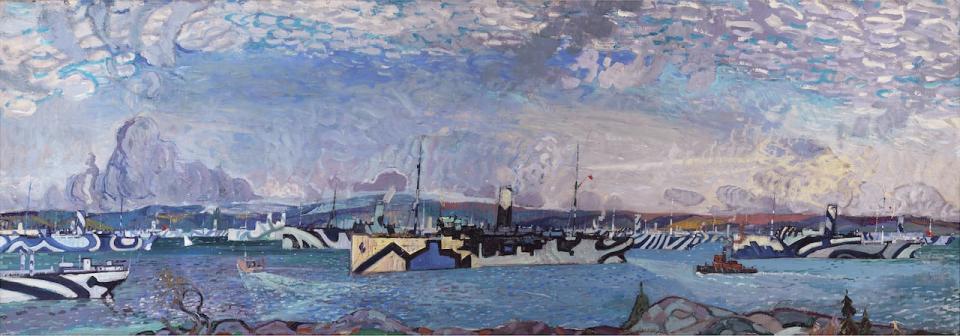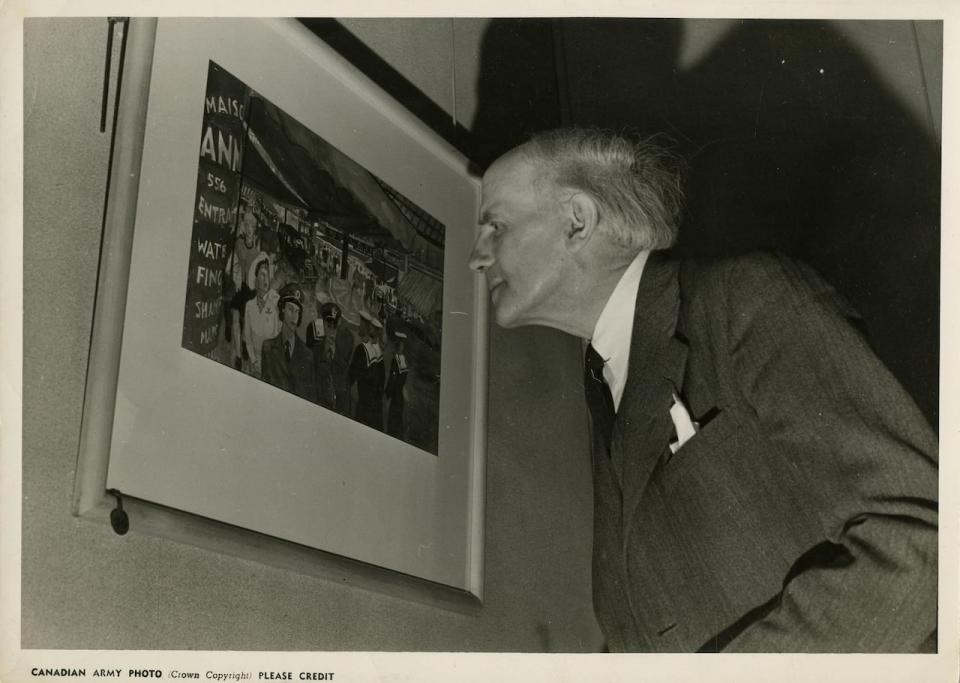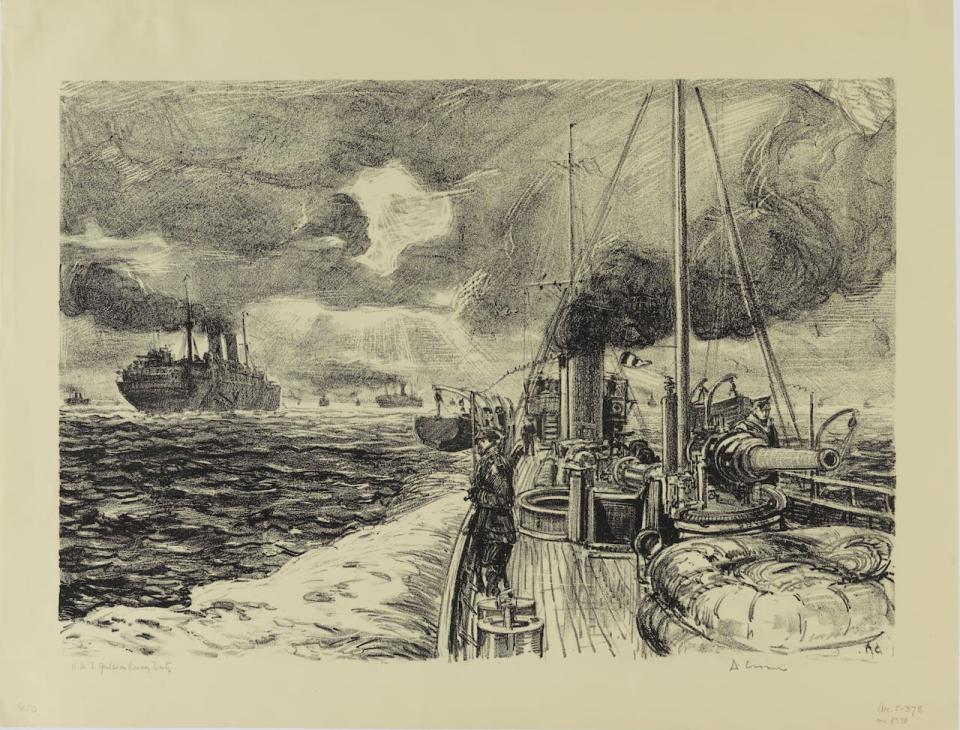Before he was a Group of Seven painter, Arthur Lismer was a wartime artist in Halifax

When artist Arthur Lismer would sketch along the Halifax waterfront during the latter years of the First World War, his efforts were often met with suspicion.
"The police would ask him, 'Hey, what are you doing here? What's going on? You can't be here,'" said Stacey Barker, a historian of arts and military history with the Canadian War Museum in Ottawa.
These encounters helped pave the way for Lismer, who later found fame as a Group of Seven artist, to become a commissioned war artist through the Canadian War Memorials Fund.
This program was started in 1916 by Max Aitken (later Lord Beaverbrook) to ensure Canada's war effort was documented through art, said Barker.
The end result was almost 1,000 works of art produced by around 120 artists, most British or Canadian, said Barker.

This Lismer painting depicts merchant ships assembling in the Bedford Basin for a transatlantic convoy. (Arthur Lismer/Convoy in Bedford Basin/CWM 19710261-0344/Beaverbrook Collection of War Art/Canadian War Museum)
From 1916 to 1919, Lismer worked in Halifax as the principal of the Victoria School of Art and Design, known today as NSCAD University.
Lismer's home on Cliff Street in Bedford overlooked Bedford Basin, giving him a view of the bustling wartime port where convoys gathered and headed overseas.
More than 66,000 Canadians and Newfoundlanders died in the war that lasted from 1914 to 1918.
Barker said Lismer wrote to Eric Brown, an official with the Canadian War Memorials Fund, and asked if he could get access to sketch in restricted areas of the city.
"I think there may have been a little bit of a misunderstanding," said Barker. "I think Brown thought Lismer was asking for a commission, so that's what he gave him."
Lismer's commission became official in June 1918, months before the war ended on Nov. 11, 1918.

Lismer is shown in a 1943 photo. (CWM 20060087-013/Canadian War Museum)
He produced three paintings and 16 lithographs, says the National Gallery of Canada's website.
As part of his work, Lismer boarded some ships, said Barker.

The Grilse was a converted yacht outfitted with two guns and a torpedo tube. It was 61.5 metres long and could make 32 knots (59 kilometres an hour) at full speed. (Arthur Lismer/H.M.S Grilse on Convoy Duty/CWM 19710261-0357/Beaverbrook Collection of War Art/Canadian War Museum)
She said he was fond of capturing "dazzle ships," which was a way of painting ships by using "oceany colours" to camouflage them from the enemy.
"They painted these ships in these crazy patterns so that enemy ships couldn't really tell what type of ship it was, how fast it's going, the direction it's going," said Barker. "It kind of deceived them so that their torpedoes wouldn't be as accurate."
At a time when photography from the First World War was captured in black and white, coloured art allowed for a different perspective.
"It has an emotional connection to the subject," said Barker. "You can feel things more than you can with a photograph, which tends to be a little bit more documentary in nature. I mean, photography can certainly be really deep and really emotional as well, but art has that feeling to it."
Lismer's work on display in Halifax
Some of Lismer's wartime work is on display until Jan. 14, 2024, at the Art Gallery of Nova Scotia in Halifax as part of an exhibit called Generations: The Sobey Family and Canadian Art, which contains art from the private collections of the Sobey family. Visiting the gallery is free for Nova Scotians as part of a pilot project during the exhibit.
"This time of year is especially resonant with Lismer because we come on these anniversaries of times where his work really has special meaning for the Halifax Explosion, Remembrance Day, really celebrating the navy here in Halifax and this work does such a good job of that," said Sarah Moore Fillmore, CEO of the Art Gallery of Nova Scotia.
After Lismer left Halifax, he became part of the famed Group of Seven, Canadian landscape painters from 1920 to 1933.
"They were painting the kind of harsh beauty of [the] Canadian landscape that has become sort of iconic for us today as a Canadian visual language," said Moore Fillmore.
Barker said Lismer's time in wartime Halifax was important to his development as an artist.
"These paintings that he does in Halifax along the waterfront, those are a type of landscape," she said. "And if you kind of compare the two, you can really see that this is an important moment in his development as an artist."
Lismer died in Montreal in 1969 at the age of 83.
MORE TOP STORIES


